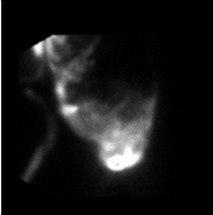Case Author(s): Jeff Chesnut, D.O. and Farrokh Dedashti, M.D. , 5/21/99 . Rating: #D2, #Q4
Diagnosis: Peritoneal/pleural fistula
Brief history:
36 year old woman with Budd-Chiari syndrome who presents with ascites and pleural effusion.
Images:

Initial images over the abdomen were obtained.
View main image(ps) in a separate image viewer
View second image(xr).
An anterior portable chest radiograph is shown.
View third image(ps).
An image over the abdomen and chest with a marker at the sternal notch is shown.
View fourth image(mm).
A scintigram of the bandage covering the chest tube insertion is shown.
Full history/Diagnosis is available below
Diagnosis: Peritoneal/pleural fistula
Full history:
36 year old woman with Budd-Chiari syndrome who presented with ascites and a right sided pleural effusion. A thoracotomy tube was placed and the patient had persistent copious drainage through the tube with resolution of her ascites.
Radiopharmaceutical:
Tc-99m sulfur colloid in 250cc saline via intraperitoneal injection.
Findings:
Images over the abdomen obtained 1 hour following instillation of radionuclide into the peritoneal cavity demonstrates activity
over the entire peritoneal cavity. The negative impression of the bowel may be seen on the initial image.
There also is activity extending along the right paracolic gutter, along the lateral margin of the liver, and into the expected location of the right lower hemithorax. Activity is also seen extending outward along the patient's chest tube and is seen collected within the patient's chest wall bandage.
Discussion:
In the instance of suspected peritoneal/pleural fistula, peritoneal cavity scintigraphy is a simple method of documenting communication between the peritoneal cavity and the chest. In this case, the drainage of the radionuclide through the chest tube confirms the fistula. In the case of a peritoneal/pleural fistula, Tc-99m sulfur colloid is normally used as it has good imaging characteristics and is very stable. Care must be taken to maintain strict sterile technique when infusing the radionuclide via paracentesis or by indwelling peritoneal catheter.
Major teaching point(s):
Peritoneal cavity scintigraphy is an effective way to evaluate the presence of a peritoneal/pleural fistula.
ACR Codes and Keywords:
References and General Discussion of Peritoneal Shunt Scintigraphy (Anatomic field:Lung, Mediastinum, and Pleura, Category:Effect of Trauma)
Search for similar cases.
Edit this case
Add comments about this case
Return to the Teaching File home page.
Case number: ps001
Copyright by Wash U MO

